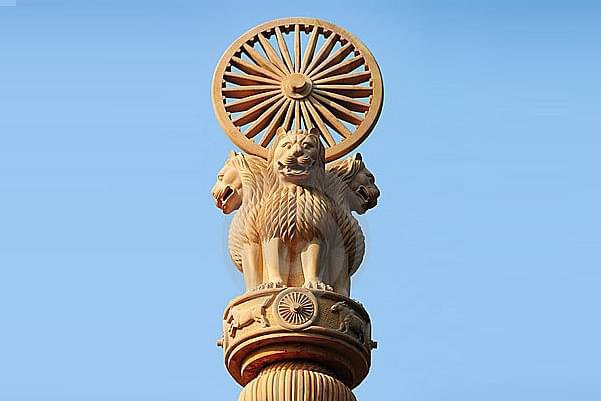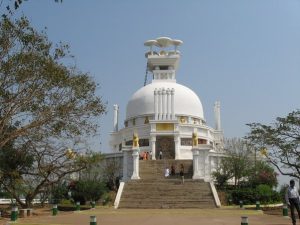Had Emperor Ashok already converted to Buddhism much before the Kalinga War was fought?


It is time to unearth the facts and counter the lies which we have been taught in our schools for generations. Yes most of Indian history is obscure because it has been manipulated by the people who came to power post Independence. Our history text books tell a lot about Mughal Rule, British Colonization, and Freedom Movements. We little know about our mighty Empires.
With respect to Ashoka, whatever is mentioned in our history books is a Lie. If you compare the conventional story of King Ashoka with that of inscription mentioned in Dhauli Hill in Bhubaneswar, it gives you an entire different perspective. He feels sorry but he warns the rest people of Kalinga that they would suffer the same consequence,if not from him then from his successors, if they do not obey him.

In Fact, Ashoka was already a Buddhist before he invaded Kalinga. There was a political reason why he embraced Buddhism. There is a book named Ashokavadana which gives details of how Ashoka’s only motive was to spread Buddhism.
In addition to your question I’d say though Ashoka was successful in invading Kalinga, Kalinga became free a generation later and there is evidence to support it. We are taught about a King named Kharavela, in Odia Literature, who was a powerful king of Kalinga Empire, who pioneered in South East Asian Trade, who ruled the entire central part of India. His inscription can be found in Hathigumpha which is in Bhubaneswar.

The inscription, though, is in Kalinga script made the following rough translation (Source is from “The Ocean Of Churn” by Sanjeev Sanyal).
I went to Pataliputra, took back the Jain idols which were taken from us and made the Mauryan ruler to kneel.
If you happen to go to Bhubaneswar, and visit Hathigumpha, you would see how interestingly the inscription of King Kharavela is placed. One would see the Dhauli hills in front of The Hathigumpha caves. In the metaphorical sense King Kharavela is expressing his vengeance to the King Ashoka.
Yes, Ashoka had converted to Buddhism much before the Kalinga War. His conversion to Buddhism was not out of any remorse or sadness. It was due to a political cause.
Bindusara had chosen his son Sushima as the next emperor. Ashoka then killed atleast six of his brothers and uspured the throne. Buddhist texts mention Ashoka killing 99 of his brothers, but this seems to be an exaggeration. So when he uspured the throne, the Ajivikas and Jains opposed him. At that time, Buddhism was a rival to these sects. So just to secure his rule, he adopted Buddhism.
Buddhists texts mention Ashoka having contacts with Buddhist monks atleast a decade before Kalinga War. Ashoka’s own inscriptions mention him adopting Buddhism atleast two years before Kalinga War. Even Ashoka’s eulogists like Charles Allen agree that his conversion predated the Kalinga war.
Ashoka never showed any remorse for Kalinga War. He had taken about 1,50,000 as captives. If he was geniunely guilty about waging a war, then why didn’t he release them?
Moreover we find no mention of any apology in Ashoka’s text for people of Kalinga, modern day Odisha. Even post Kalinga War, he had got 18000 Ajivikas in Bengak killed.
Ashokavandana mentions another story which shows the brutality of Ashoka. A Jain painter had made a painting showing Buddha showing respect to a Jain Tirthankar. So Ashoka locked him along with his family in a house and burnt them alive.
Ashokavandana also mentions Ashoka announcing that he would give one gold coin for one head of a Jain. Coincidentally, someone had mistaken his full brother Vittashoka to be a Jain and had killed him. It was after this that he started following non-violence.
He just emptied his treasury in spreading Buddhism and weakened his empire. And later his non-violence also killed the warrior spirit of the soldiers, which paved the way for the weakness of the glorious Mauryan Empire set up by Chandragupta Maurya and Acharya Chanakya. His weak successors didn’t help either and further weakened the Mauryan Empire, which paved the way for Pushyamitra Sunga to establish Sunga dynasty , after killing the last Mauryan king Brihadratha.
Ashoka converting to Buddhism post Kalinga war out of remorse is nothing but a propaganda to show Hinduism in a bad light and Buddhism in a poisitive light.
Ashok became Buddhist 2 years prior to invading Kalinga. This fact has been brought out by Shri Sanjeev Sanyal. Please see his article on Swarajya magazine website: Ashoka, The Not So Great. Shri Sanjeev Sanyal has also given a lecture in Jan 2016 at Press Club of India on the topic “How Much of Indian History is Really True?”
By giving example of Ashok, Shree Sanjeev Sanyal has tried to prove that most of the Indian history as taught in schools and colleges is false. It was started by British and continued with Congress with the help of Communist academicians. 300-400 years back Europe was very poor. When British colonized India they falsified their history to project themselves as liberators of India. At the same time they falsified Indian history to kill the self-esteem of the local population. A very good reference for India and Europe’s true history for last 2000 years is given in the book “From Bharat to India : Vol 2 : The rape of Chrysee” By M.K.Agarwal. This book uses more than 700 references both from Europe and India.
What is more horrific is that he committed the atrocities after he converted to Buddhism.
In the book titled: The Legend Of King Asoka: A Study And Translation Of Aśokāvadāna, John Strong guides us through the Buddhist text with his skilful translation and with his ever lucid commentary.
In a related episode, he locks a Jain layman and his family inside their home, sets the place on fire, and then launches a veritable pogrom against the Jains, setting a bounty on the head of any heretic.
It was not a one-time thing.
In the meantime, in the city of Puņdavardhana, a lay follower of Nirgrantha Jñātiputra drew a picture showing the Buddha bowing down at the feet of his master. A Buddhist devotee reported this to King Asoka, who then ordered the man arrested and brought to him immediately. The order was heard by the nāgas as far as a yojana underground, and by the yakşas a yojana up in the air, and the latter instantly brought the heretic before the king. Upon seeing him, Aśoka flew into a fury and proclaimed: “ All of the Ājīvikas in the whole of Pundavardhana are to be put to death at once!” And on that day, eighteen thousand of them were executed.
Another:
Sometime later, in Pāțaliputra, a different devotee of Nirgrantha drew yet another picture of the Buddha bowing down in front of his master. When Asoka heard about this, he was without mercy. He forced the man and his whole family to enter their home and burnt it to the ground. He then issued a proclamation that whoever brought him the head of a Nirgrantha heretic would be given a reward of one dīnāra.
How this fiasco ended also finds a mention in the text and is a classic example of karma in its glory:
Now around that time, the Venerable Vitaśoka decided to spend the night in the house of a cowherd. Because of his illness, his clothes had become tattered and his nails, hair and beard had grown long; and the cowherd’s wife thought it was a Nirgrantha who had come to spend a night in their house. So she said to her husband: “My lord, that dīnāra is as good as ours; let’s kill this Nirgrantha and present his head to King Asoka.” The cowherd, unsheathed his sword and approached the venerable monk. Vītaśoka just sat there. He accepted the facts of karma, and calling upon his knowledge of his past lives, he realized that the time had come for him to reap the fruit of some of his own previous misdeeds. The cowherd then cut off his head, took it to King Aśoka and asked for his 69 dināra reward.
Asoka did not immediately realize whose head it was for the unusual amount of hair prevented him from recognizing his brother. But the servants who had attended Vitaśoka were called in and upon seeing it, they proclaimed: “ Your majesty, this is Vitaśoka’s head!” And hearing this, the king collapsed in a faint. He was revived by his ministers who splashed some water in his face . “Your majesty,” they declared, “this is an example of the suffering that is being inflicted even on those who are free from desire; you should guarantee the security of all beings!” Aśoka followed their advice, and thenceforth , no one was ever condemned to death again.
Vitaśoka was Aśoka’s brother!
Addendum:
For the uninitiated, Nigrantha refers to Jains. Bharata Muni in his ‘Nāṭyaśāstra’ confirms
Chapter XXIII – Costumes and Make-up (nepathya) 146–147 in Rules of different hairs;
146-147. The head [in the mask] of the Buddhists (śākya), monks experts in Vedic studies (śrotriya), the Jain (Nirgrantha) monks, wandering ascetics, and those who have consecrated themselves for some rites or for a Vedic sacrifice, should have their heads shaven clean. And according to their, [respective] sectarian doctrine the remaining ascetics should have their heads shaven or should have curling hairs or hairs loosely hanging down.
Did King Ashoka fight wars after converting to Buddhism?
Yes, he did.
A growing consensus among historians and scholars is that the War of Kalinga occurred after Ashoka had already converted to Buddhism. This view has been popularised by historians such as Sanjeev Sanyal and Charles Allen. Allen, who interestingly seems to absolutely adore Ashoka, gives this chronology:

So Ashoka did wage war after his supposed conversion to Buddhism. Even after the Kalinga War and his supposed remorse, Ashoka did not become a pacifist and maintained his large army to keep his empire intact. On the Major Rock Edict XIII, which currently is in Kandahar IIRC, he shows remorse on the suffering of the people of Kalinga but he also warns the forest-tribes of the region where the Edict was placed that if they do not repent they shall suffer the same fate as the people of Kalinga. I wouldn’t call that non-violence.
This isn’t historical revisionism. The Ashokavadana, the earliest known textual source on Ashoka, does not say that the War of Kalinga triggered Ashoka’s conversion to Buddhism; apparently it was a personal decision. IMO, Ashoka became a Buddhist to get on the good side of the rapidly growing Buddhist Sangha which was fast becoming a politically and socially relevant organisation, much like the Catholic Church in Medieval Europe.
Then there’s the matter of the allegedly state-sponsored Jain and Ajivika massacres under Ashoka’s reign, which are also mentioned in the Ashokavadana. Again we see Ashoka resort to violence, although not outright war.
The Indologist AL Basham was of the opinion that although Ashoka might have personally practiced Buddhism and given it royal patronage, the Dhamma that he refers to in his Edicts might not have been Buddhism at all but more like some ‘Law of Piety’. He believes the Edicts to have been ‘propaganda pronouncements’. [See – Article ]
It is time to unearth the facts and counter the lies which we have been taught in our schools for generations.
DISCLAIMER: The author is solely responsible for the views expressed in this article. The author carries the responsibility for citing and/or licensing of images utilized within the text.
